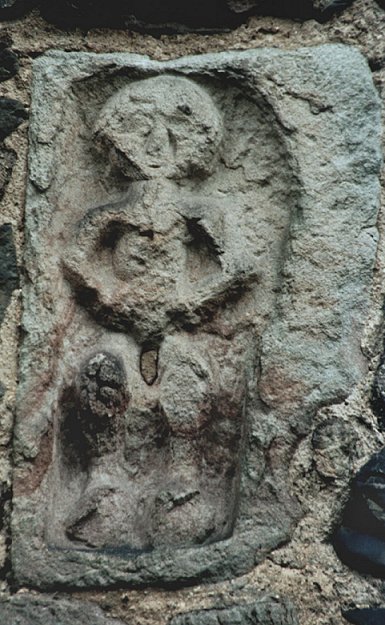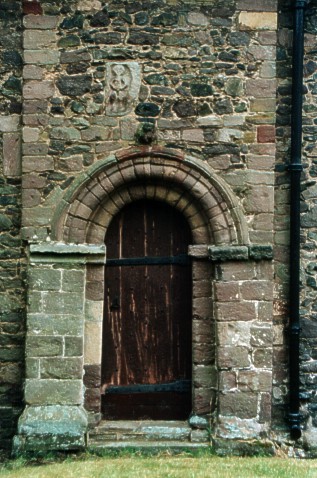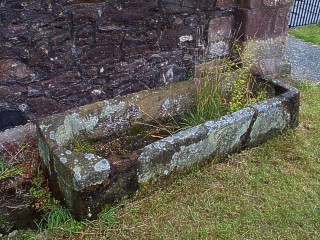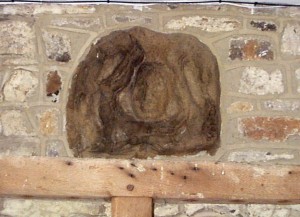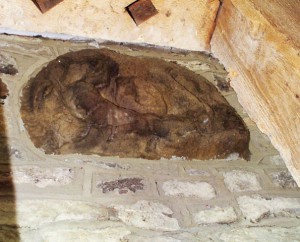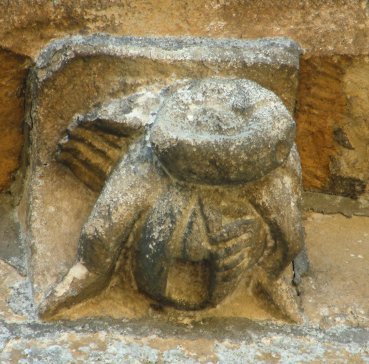
The Figures
St Nicholas church, Studland is something of a neglected treasure house of romanesque carving. It lies on the Dorset coast in the Isle of Purbeck.
The Studland Sheela is mentioned in passing in Images of Lust (page 117) but other than that there is very little mention of the figure in Sheela literature. A local guide book to the village of Studland mentions that there has not been much research into the corbel table of the church despite the richness of the carvings. The style of the carving on the corbel table is very much like that of Stoke Sub Hamdon even including some truly abstract figures. The figure has the left hand holding open an grossly exaggerated vulva with a clearly defined clitoral hood. The right hand is also exaggerated and it’s execution makes it look more like a fin than hand (you can see this jutting out on the left hand side of the photo). It has no body to speak of, a badly worn face is directly joined to a pair of legs and the vulva. The adjacent figure gives you some idea of how it might have looked when new. Near the sheela there is also an acrobatic figure which could also be a less obvious exhibitionist. the figures upside down head is placed between it’s knees the while the whole body is bent backwards. Between the legs there appears to be a suggestion of a vulva complete with clitoral hood, this is however open to interpretation. On the other side of the church a pair of lovers embrace and appear to be enaged in intercourse. Another figure on the corbel table has been identified as broken megaphallic male by Malcolm Thurlby 1. The penis is now missing but the gigantic testicles can still be seen. It’s well worth paying careful attention to the figures as a few are not always what they seem to be, an abstract pattern on closer inspection becomes the head of two grimacing monsters. The carving on the church on the whole is well executed if now a little worn. It’s surprising that more research into the church has not been done as while it’s corbel table may not be as well preserved as Kilpeck the richness of the carving rivals that famous church.
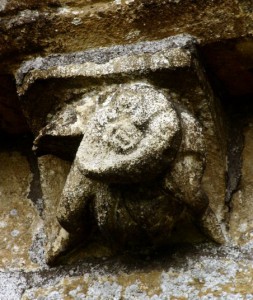
A view of the Studland sheela with the crudely carved face clearly visible. On a previous visit during a bright summer day the face invisible as can be seen from the photo aProceedings of the Dorset N.H. and A.F. Clubbove. Its also interesting to note that the article below from the Proceedings of the Dorset N.H. and A.F. Club also shows the figure as faceless. The picture to the left was taken on an overcast winters day and the face was clearly visible.
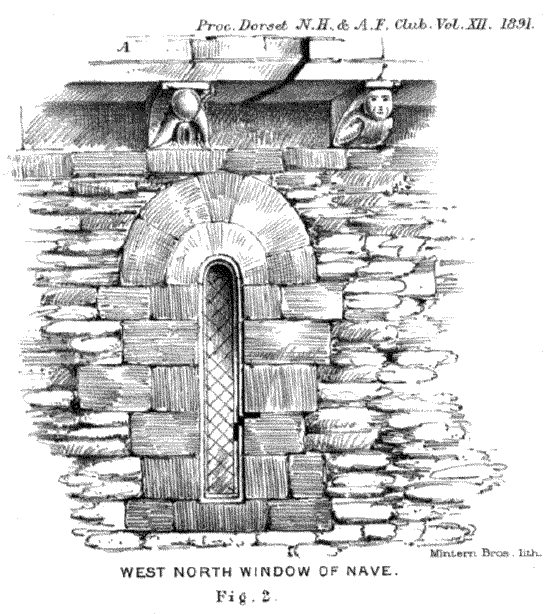
This figure appears in a somewhat abstract form in A Study on the Work of Preservation of the Church of St Nicholas, Studland, Dorset from the Proceedings of the Dorset N.H. and A.F. Club Vol. XII. 1891 as can be seen below. It interesting to note that the figure has not undergone the usual Victorian bowdlerisation prevalent in many studies of the period. A PDF copy of this report can be downloaded from Dr Colin Parsons site on the church here.
Proceedings of the Dorset N.H. and A.F. Club

The Sheela with adjacent figure. The adjacent figure may be playing a rote, a type of lyre. This would seem likely as musicians are often found on corbel tables. There is a sculpture of an ass playing a rote in Oakham castle where the instrument is depicted in a similar blocky manner 2. The nearby church of Worth Matravers also holds a rote playing figure on the corbel table the body is more awkwardly twisted than the example on Studland.
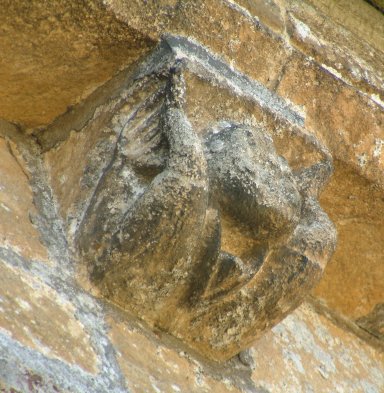
Adjacent acrobatic figure possibly another exhibitionist i.e. the clitoral hood is directly above the head.
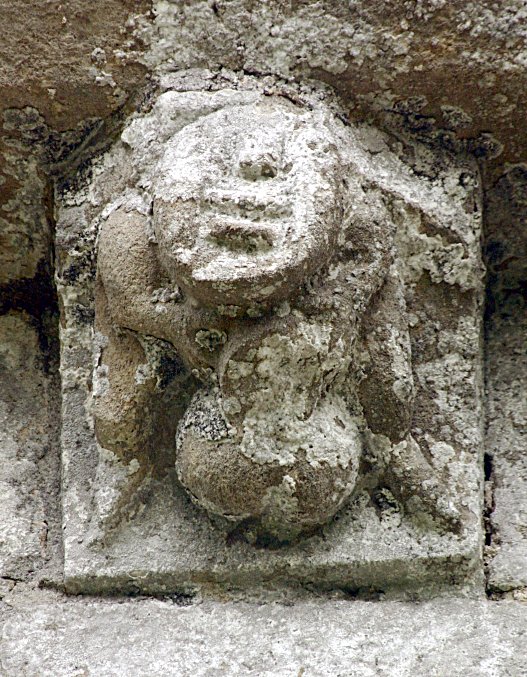
This figure has been identified as a broken phallic male by Malcolm Thurlby and Anthony Weir. At first I was somewhat doubtful of this interpretation but as you can see from the photograph it is indeed a broken megaphallic male.The hands can be seen still grasping the grossly enlarged base of the penis the remnants of which can still just be made out under the encrustation of lichen. It’s interesting to note that both the male and female figure on the church are exaggerated or megaphallic and megavulvic respectively
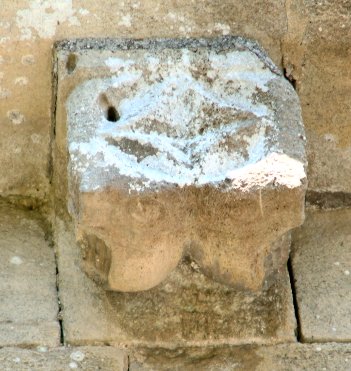
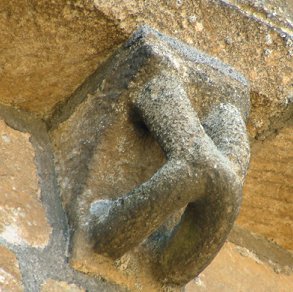
Abstract Corbel (compare to Stoke Sub Hamdon figures)
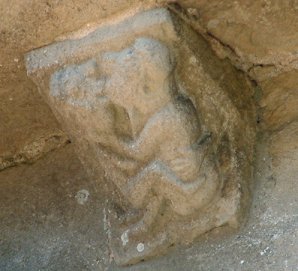
The Lovers. This corbel, while not overtly exhibitionist does seem to represent a couple having intercourse. It’s worth comparing these figures to the lovers at Kilpeck which are more chaste in their embrace.
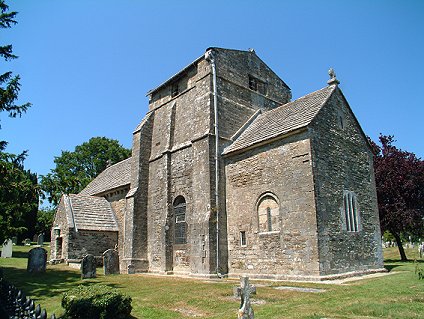
1. The Romanesque Church of St Nicholas, Studland (Dorset)”, Malcom Thurlby and Karen Lundren in Proceedings of the Dorset Natural History and Archaeological Society.
2. Art and Patronage in the English Romanesque. Sarah Macready Ed. and F.H. Thompson Ed. page 103
Location
